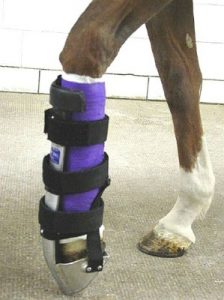Large animal wounds
Flexor tendon damage
The flexor tendons run on the palmar/plantar aspects of the limbs and are responsible for limb support. If flexor tendons are partially damaged, weight bearing can lead to complete tears. It is important to stabilize these injuries as soon as possible to minimize further damage.

- Fetlock sinking a little lower = superficial digital flexor tendon disruption
- Toe up = deep digital flexor tendon disruption
- Fetlock really sinking = suspensory ligament disruption
- Hock dropped = gastrocnemius /calcanean tendon disruption
These videos are related to degeneration vs injury but should give you the idea; we don’t walk the injured ones!
Example of toe up indicating DDFT disruption
Example of suspensory degeneration
The limb should be casted or splinted with the heel elevated (ballet dancer position) for the flexor tendons. Kimsey leg saver splints are great for this when available and when they fit the patient.

Prognosis is guarded for performance.
In larger animals, it is really hard to recreate the calcanean tendon or stabilize the limb for healing and euthanasia is usually indicated for gastrocnemius or calcanean tears.
Key Takeaways
If the wound involves the palmar or plantar aspect of the limb, check the limb conformation when weightbearing to see if tendon disruption has occurred. If you can feel a partial tear, stabilize the limb to prevent further tearing. The easiest way is to cast the limb with the toe pointed down (heel elevated).

